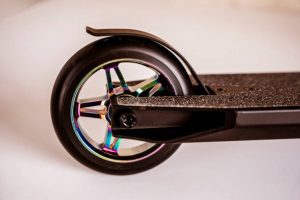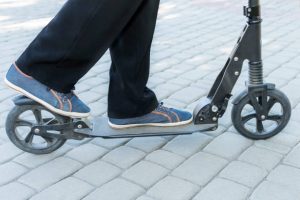We’ve all experienced the thrilling rush of zipping around on a scooter, weaving through traffic, or cruising down open roads. It’s exhilarating, right? We believe in having fun without compromising on safety. That’s why it’s important to understand the key element of scooter safety, the humble scooter brake system.
Scooter brakes are essential safety components designed to ensure precise control and stopping power for scooters, allowing riders to navigate smoothly and stop effectively when needed. These braking systems, commonly equipped with brake pads, play a crucial role in the overall safety of scooters, enhancing the reliability and responsiveness of these popular urban transportation devices.

In this article, we’ll look into all you need to know about how scooter brakes work, common myths about them, and tips on choosing the right brake system for your needs.
When it comes to scooters, you will encounter several types such as electric scooters, gas-powered scooters, and manual scooters. Electric scooters are powered by a rechargeable battery, gas-powered scooters use gasoline, and manual scooters rely on the user’s feet to propel them.
Understanding how these brakes work and how to maintain them can make all the difference between a smooth, enjoyable ride and an unfortunate accident. With that in mind, let’s look at the basics of electric scooter brakes – from how they function to debunking common myths surrounding them.
The basic components of a scooter brake system include the scooter brake lever, brake pads, cables, and calipers. The brake lever is connected to the brake pads and, when pressed, causes the brake pads to rub against the wheel’s rim and slow the scooter down. The cables act as a link between the brake lever and the calipers which, when pressed, squeeze the brake pads against the wheel’s rim.
It’s important to regularly maintain your scooter’s brake system. This includes checking for wear and tear, lubricating the cables, and making sure the brake pads are always clean and free of dirt and debris. If you notice any signs of wear or damage, be sure to take your scooter to a qualified mechanic to get it fixed as soon as possible.
At FamilyHype, we care about helping our readers have fun and stay safe on their scooters. So, we hope that this article has given you a better understanding of how your scooter’s brake system works and how to maintain it for a fun and safe ride. If you have any questions or feedback, we’d love to hear from you in the comments below.

Understanding The Basics Of Brakes
You’ve got to grasp the basics of scooter brakes if you’re going to enjoy a fun and safe ride. Electric scooters offer a variety of braking systems, including drum brakes, disc brakes, regenerative scooter brakes, and cable brakes. Each braking system has its unique benefits that need to be considered when selecting the right one for your scooter.
We understand that choosing the right brake system can be overwhelming, but we’re here to guide you through this process empathetically and authoritatively.
Now that you’ve gained some preliminary understanding, let’s delve into how these braking systems function in action. Drum brakes are the simplest and least expensive brake system, consisting of a drum and a lever-activated brake pad. Disc brakes are more expensive but provide greater stopping power as the brake pad is applied directly to the wheel. Regenerative brakes recapture energy created during braking and convert it into electricity to charge the battery, while cable brakes are a hybrid system of both mechanical and cable-activated brakes.
No matter which brake system you choose, remember to share your feedback and experience with us. We love hearing from our readers and value your input! With a better understanding of scooter brakes, you’ll be well on your way to a fun and safe scooter ride.

How Do You Pull Over Your Ride?
Ever wondered how you’re able to stop on a dime while zipping around on your two-wheeled speed machine? It’s all about the brake system, found in electric scooters.
Here at FamilyHype, we understand the importance of safety and regular brake maintenance. That’s why we want to share with you how electric scooter brakes work:
- Brake lever: Activates the braking process.
- Cables: Transmit force from lever to brakes.
- Brake Pad/Shoe: Creates friction against the wheel.
Brake innovations have significantly reduced scooter accidents. With the right equipment and regular maintenance, you can ensure your safety and the safety of those around you.
From disc brakes to drum brakes, electric scooters come with a variety of brake types and features. We encourage you to share your experiences and knowledge in the comment section below to help others stay safe!

The Importance Of Regular Maintenance
Maintaining your two-wheeler’s stopping brake system regularly might seem like a chore, but it’s crucial for ensuring smooth and secure rides. Brake adjustments and monitoring brake wear should be part of your routine care, including parts accessories.
It shows not only respect for your safety but also a commitment to the well-being of others sharing the road with you. This knowledge will come in handy when learning how to use brakes effectively on scooters.
Understanding the importance of regular brake maintenance not only helps create a safe environment for you and other riders on the road but also reflects the values of the FamilyHype community — a community of parents and people that highly value the family unit.
Whether you’re a beginner or a pro, be sure to take the time to check and adjust your brake system if necessary, so you can ride with confidence and be prepared for any situation.
We would love to hear your thoughts and feedback on this topic, so please don’t hesitate to share your experiences and opinions with us.
How To Slow Down Or Reduce Speed Immediately
When it comes to scooters, mastering the art of effective braking can make a world of difference in your two-wheeler journeys. It’s not just about stopping; it’s about brake timing and brake distribution. With proper use, we can prevent accidents and ensure everyone’s safety.
But unfortunately, there are still many misconceptions surrounding scooter brakes. At FamilyHype, we believe that understanding the fundamentals of scooter brakes is key to ensuring safety. That’s why we encourage our readers to share their feedback, experiences, and opinions about scooter brakes.
Let’s debunk some of the most common myths and stay safe on the roads!
Common Myths About Slowing Down
Contrary to popular belief, there’s a lot of misinformation swirling around the proper use of two-wheeler brakes, especially for electric scooters. We’ve heard several break misconceptions and performance myths that FamilyHype writers and editors, who are either parents or people that highly value the family unit, have heard:
- You only need the front brake: This can lead to dangerous over-reliance. Both the front and rear brakes are necessary for a safe ride.
- Brakes should squeak: This is a sign of wear or misalignment, not an indication of proper braking.
- More brake power means safer rides: Overuse can cause skidding, so it is important to use the brakes appropriately.
Understanding these myths about scooter brakes helps riders choose the right brake system for their needs. If you have any thoughts or experiences you would like to share with us, please do so in the comments below.
Tips For Choosing The Right Braking Systemm For Your Needs
Just like picking the perfect pair of shoes, selecting the right braking system for your two-wheeler can make a world of difference in your riding experience. As this content isn’t for gas-powered scooters, it’s crucial to consider brake adjustments and materials that suit your needs.
Let’s opt for durable, high-quality materials which offer consistent performance and ensure we understand how to adjust them effectively. This way, we’ll ensure our rides are safe while serving others with our responsible choices.
When it comes to scooters, there are many brake systems to choose from, such as drum brakes, disc brakes, and V-brakes. Consider attributes such as power, durability, and noise level when selecting the right scooter brake system for you.
At FamilyHype, we highly value the family unit and encourage the reader to share any feedback or opinions they may have on this article.
Conclusion: Taking Care Of Your Pedals To Ensure Safety
We’ve walked you through the ins and outs of scooter brakes, a key component for fun and safe scooter rides. We’ve discussed their function, maintenance, effective use, common misconceptions, and tips on choosing the right system.
When it comes to scooter safety, brakes are paramount. So, we must understand the importance of good quality brakes. As FamilyHype editors and writers who value the family unit, we want to make sure you know to enjoy your ride with confidence.
We hope this article has provided you with valuable information about scooter brakes and that you’ll share your experience and feedback with us. Enjoy your ride with confidence!
FAQs
What brakes to use on a scooter?
Scooters typically use either drum brakes or disc brakes. The type of brake used can vary depending on the scooter model and manufacturer.
Do scooters have front or rear brakes?
Scooters generally have both front and rear brakes for effective braking. Having brakes on both wheels helps distribute the braking force and improve overall stopping power.
Which is the front brake on a scooter?
The front brake on a scooter is typically located on the right side of the handlebar. It is operated by squeezing the lever with your right hand.
Which is the left brake or right brake on a scooter?
The left brake lever on a scooter is typically for the rear brake. It is located on the left side of the handlebar and is operated by squeezing the lever with your left hand.
How do you slow down a scooter?
To slow down a scooter, gently apply the brakes by squeezing the appropriate brake lever. Apply gradual pressure to avoid sudden stops or skidding. Additionally, you can release the throttle or decrease the throttle input to reduce speed.
Which brake is better for my scooter: drum or disc brakes on a scooter?
Disc brakes generally offer better stopping power and more consistent performance compared to drum brakes. They provide improved heat dissipation, which can be beneficial for repeated and heavy braking. However, drum brakes can still be effective and reliable, particularly in smaller scooters or under lighter braking conditions.
Do you use the drive or handbrake first?
In normal scooter operation, you typically use the drive (throttle) to accelerate and control the scooter’s speed. The handbrake is used for slowing down or stopping the scooter when needed. So, you would use the drive first and then apply the handbrake when you want to slow down or stop.
What are rear brakes used for?
The rear brakes in a scooter are used primarily for slowing down and stopping the scooter. They provide additional braking power and stability, helping to balance the deceleration forces between the front and rear wheels.
Can you use the handbrake while driving?
Yes, you can use the handbrake (rear brake) while driving a scooter. However, it is important to use it judiciously and in appropriate situations. Using the rear brake while driving can help slow down the scooter gradually or provide additional stopping power, especially in emergencies.
What happens if you don’t use the handbrake?
If you don’t use the handbrake, it can affect your ability to slow down or stop the scooter effectively. Relying solely on the drive (throttle) without utilizing the handbrake can compromise your control and may lead to unsafe situations, especially when you need to slow down or stop suddenly. It is important to utilize both the drive and handbrake to maintain safe and controlled scooter operation.
DISCLAIMER (IMPORTANT): This information (including all text, images, audio, or other formats on FamilyHype.com) is not intended to be a substitute for informed professional advice, diagnosis, endorsement or treatment. You should not take any action or avoid taking action without consulting a qualified professional. Always seek the advice of your physician or other qualified health provider with any questions about medical conditions. Do not disregard professional medical advice or delay seeking advice or treatment because of something you have read here a FamilyHype.com.